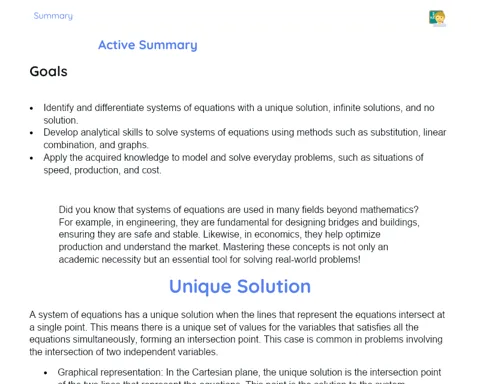Sequences: Missing Elements | Socioemotional Summary
Objectives
1. Recognize and identify patterns in sequences of natural numbers, objects, or figures.
2. Fill in the missing elements in a sequence by applying the identified pattern rule.
Contextualization
Did you know that sequences are everywhere in our daily lives? From organizing the days of the week to forming patterns in games and nature, they help us predict the next step. Understanding how they work can be the key to solving puzzles and even to performing well in your daily activities. Shall we discover together?
Important Topics
Sequences
A sequence is an ordered collection of numbers, objects, or figures that follow a specific rule. Sequences help us understand how the elements relate to each other, allowing us to predict the next item based on an identified pattern. By studying sequences, we develop observation and logic skills that are useful in various everyday situations.
-
Numerical Sequence: A classic example is the sequence 2, 4, 6, 8, where the rule is to add 2 to the previous number.
-
Object Sequence: Like in 🟠, 🔵, 🟠, 🔵, where the rule is to alternate between different colors or shapes.
-
Importance in Daily Life: From organizing the days of the week to forming patterns in games and nature, recognizing sequences helps us understand and predict future events.
Patterns
A pattern is the regularity or repetition that can be identified in a sequence. Identifying patterns is like finding the beat of a song: once we recognize it, we can predict what comes next. This brings us a sense of security and control, as we understand the rules of the game.
-
Definition: Patterns are the key to understanding and completing sequences.
-
Practical Application: Recognizing patterns helps in problem-solving and making informed decisions.
-
Connection with Emotions: Finding a pattern generates a sense of achievement and boosts confidence.
Missing Elements
Missing elements are the items that are absent in a sequence and need to be identified based on the established pattern. Finding these elements can be an exciting challenge that tests our observation and reasoning abilities. It's like solving a puzzle, and the satisfaction of finding the correct answer is immense.
-
Identification: Observe the pattern of the sequence and apply the rule to find the next item.
-
Development of Logical Thinking: Finding the missing element helps develop logical reasoning and problem-solving skills.
-
Satisfaction and Reward: Completing a sequence correctly brings a sense of accomplishment and boosts self-confidence.
Key Terms
-
Sequence: An ordered collection of numbers, objects, or figures that follow a specific rule.
-
Pattern: The regularity or repetition that can be identified in a sequence.
-
Missing Element: The item that is absent in a sequence and needs to be identified based on the established pattern.
To Reflect
-
How did you feel when trying to identify the patterns in the sequences? Did you feel confident or challenged? How did you cope with these feelings?
-
When you found missing elements, what strategy did you use to identify them? Did it help you feel more secure in solving the problem?
-
How can you use the skill of recognizing patterns and sequences in other areas of your life? Think of practical examples.
Important Conclusions
-
🎯 We learned to recognize patterns in sequences of numbers, objects, and figures.
-
🔍 We identified and filled in missing elements in various sequences by applying the rules of the patterns.
-
🧩 Understanding sequences helps us develop mathematical and logical reasoning skills, which are essential for daily life and other subjects.
Impact on Society
Sequences are everywhere, from organizing our daily routines to the nature around us. Recognizing patterns in sequences allows us to predict future events and make better-informed decisions. For example, by identifying the sequence of the days of the week, we can plan our school activities and leisure time more efficiently.
Emotionally, finding patterns and completing sequences brings us a sense of satisfaction and accomplishment. This skill strengthens our self-confidence and teaches us to handle challenges in a calmer and more assertive way. Mathematics becomes more than just numbers; it becomes a tool for solving problems and achieving goals.
Dealing with Emotions
Let's practice the RULER method to handle our emotions while studying sequences. First, recognize how you feel when facing a math challenge. You might feel frustration or excitement. Try to understand why you're feeling this way. Name that emotion and express it appropriately, like writing about your feelings in a journal. Finally, regulate your emotions by taking deep breaths and reminding yourself that each challenge is an opportunity for learning and growth. Practice this daily and see how your emotional control improves!
Study Tips
-
📚 Study with friends and try to solve sequences together. This makes learning more fun and collaborative.
-
📝 Draw or use objects to visualize the sequences. Sometimes, seeing patterns with your eyes makes understanding easier.
-
⏱ Set aside a specific time in your day to study sequences. Consistent practice helps solidify knowledge.



